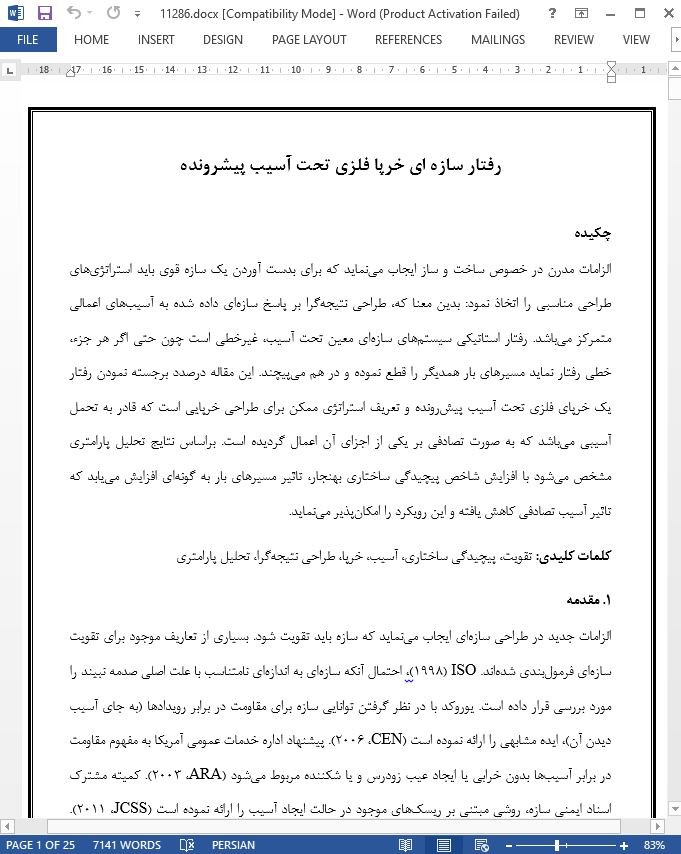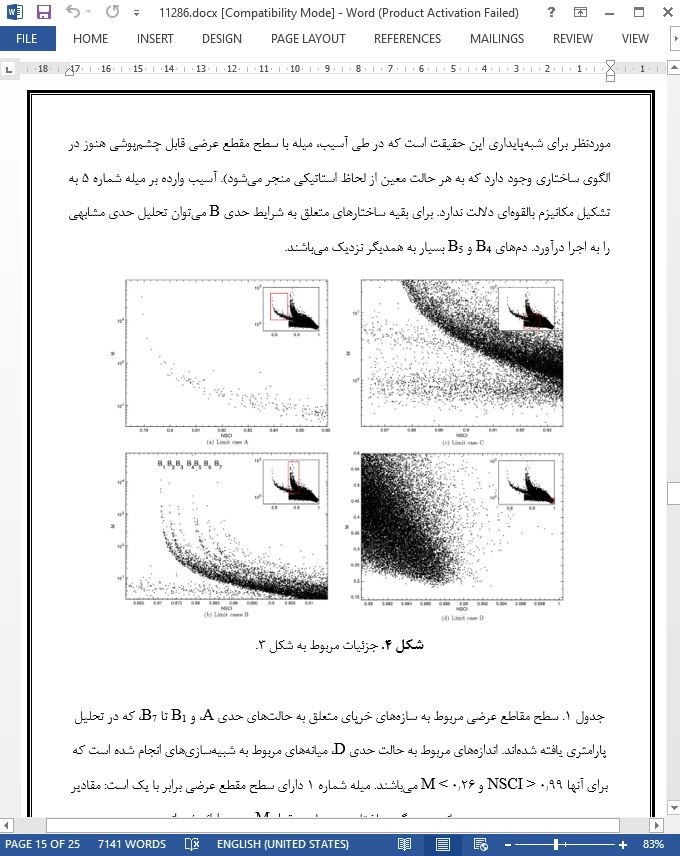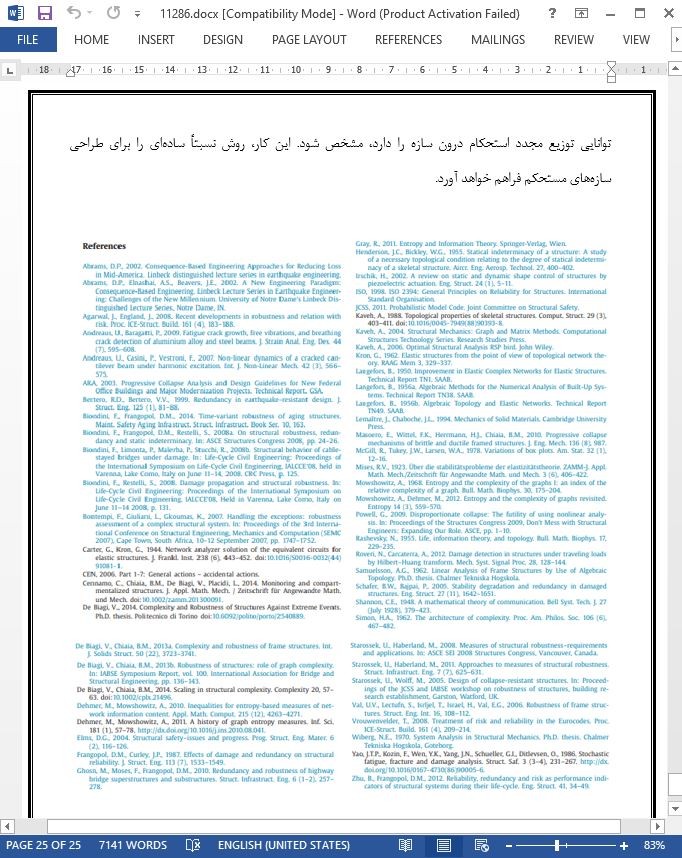
رفتار سازه ای خرپا فلزی تحت آسیب پیشرونده
چکیده
الزامات مدرن در خصوص ساخت و ساز ایجاب مینماید که برای بدست آوردن یک سازه قوی باید استراتژیهای طراحی مناسبی را اتخاذ نمود: بدین معنا که، طراحی نتیجهگرا بر پاسخ سازهای داده شده به آسیبهای اعمالی متمرکز میباشد. رفتار استاتیکی سیستمهای سازهای معین تحت آسیب، غیرخطی است چون حتی اگر هر جزء، خطی رفتار نماید مسیرهای بار همدیگر را قطع نموده و در هم میپیچند. این مقاله درصدد برجسته نمودن رفتار یک خرپای فلزی تحت آسیب پیشرونده و تعریف استراتژی ممکن برای طراحی خرپایی است که قادر به تحمل آسیبی میباشد که به صورت تصادفی بر یکی از اجزای آن اعمال گردیده است. براساس نتایج تحلیل پارامتری مشخص میشود با افزایش شاخص پیچیدگی ساختاری بهنجار، تاثیر مسیرهای بار به گونهای افزایش مییابد که تاثیر آسیب تصادفی کاهش یافته و این رویکرد را امکانپذیر مینماید.
1. مقدمه
الزامات جدید در طراحی سازهای ایجاب مینماید که سازه باید تقویت شود. بسیاری از تعاریف موجود برای تقویت سازهای فرمولبندی شدهاند. ISO (1998)، احتمال آنکه سازهای به اندازهای نامتناسب با علت اصلی صدمه نبیند را مورد بررسی قرار داده است. یوروکد با در نظر گرفتن توانایی سازه برای مقاومت در برابر رویدادها (به جای آسیب دیدن آن)، ایده مشابهی را ارائه نموده است (CEN، 2006). پیشنهاد اداره خدمات عمومی آمریکا به مفهوم مقاومت در برابر آسیبها بدون خرابی یا ایجاد عیب زودرس و یا شکننده مربوط میشود (ARA، 2003). کمیته مشترک اسناد ایمنی سازه، روشی مبتنی بر ریسکهای موجود در حالت ایجاد آسیب را ارائه نموده است (JCSS، 2011). بسیاری از نویسندگان با مفهوم قدرتمندی روبرو میباشند که ویژگیهای مختلفی که یک سازه را به عنوان یک سازه قوی تعریف مینمایند را ارائه مینمایند (آگراوال و انگلند، 2008؛ بیوندینی و همکاران،، 2008 الف؛ بونتمپی و همکاران، 2007؛ استاروسک و هابرلند، 2011؛ وال و همکاران، 2006). وروونولدر (2008) اظهار مینماید که یک سازه قوی نباید در مقابل آسیبهای موضعی، منبع آسیب، حساسیت بالایی داشته باشد.
6. نتیجهگیری
به طور خلاصه، پاسخ یک سازه خرپا در مقابل آسیبهای وارده مورد بررسی قرار گرفته است. انرژی کشسانی به عنوان معیاری برای ارزیابی اثرات آسیب پیشرونده مورد استفاده قرار گرفته است. برای ارزیابی بهتر پاسخ کلی، متوسط اندازه افزایش کار تغییرشکل از طریق پارامتر M مورد بررسی قرار گرفته است. علاوه بر این، رابطه بین مقدار شاخص پیچیدگی ساختاری بهنجار و M مورد بررسی قرار گرفته است. پارامتر اولی، معیاری از تاثیر مسیرهای بار در سراسر سازه میباشد. در کل محاسبات انجام شده، کانتیلور خرپایی متشکل از هشت گره و 15 میله مورد استفاده قرار گرفته است.
Abstract
Modern requirements on constructions impose that proper design strategies must be adopted in order to obtain a robust structure: in this sense, consequence-based design focuses the attention on the structural response to damage. The behavior of statically indeterminate structural systems under damage is nonlinear because the load paths intertwine each other, even if each component behaves linearly. The paper aims both to highlight the behavior of a metallic truss under progressive damage and to define a possible strategy for designing a truss that is able to sustain damage acting at random on one of its elements. Structural complexity is used as a leading parameter. Following the results of a parametric analysis, it emerges that, as much as the Normalized Structural Complexity Index increases, the efficacy of the load paths is spread such that the impact of random damage decreases, making the approach feasible.
1. Introduction
The modern requirements in structural design impose that a structure has to be robust. Many definition of structural robustness have been formulated. ISO (1998) considers the possibility of a structure not to be damaged to an extent disproportionate to the original cause. The Eurocode proposes a similar idea, considering the ability of the structure to withstand events, instead of being damaged (CEN, 2006). The American General Services Administration proposal relates to the concept of the resistance to damage without premature and/or brittle failure (ARA, 2003). The Joint Committee on Structural Safety’s document proposes an approach based on risk at a damage state (JCSS, 2011). Many authors have dealt with the concept of robustness proposing various properties that define a structure as robust (Agarwal and England, 2008; Biondini et al., 2008a; Bontempi et al., 2007; Starossek and Haberland, 2011; Val et al., 2006). Vrouwenvelder (2008) states that a robust structure should not be too sensitive to local damage, whatever the source of damage.
6. Conclusions
In summary, the study of the response of a truss structure to damage has been performed. The elastic energy was used as a measure for assessing the effects of progressive damage. In order to better evaluate the overall response, the average measure of the increment of deformation work was considered through the parameter M. In addition, the relationship between the value of the Normalized Structural Complexity Index and M was investigated. The former parameter is a measure of the efficacy of the load paths across the structure. A truss cantilever made of eight nodes and 15 rods was used throughout the calculations,
چکیده
1. مقدمه
2. پسزمینه نظری
2. 1. پیچیدگی ساختاری
2. 2. آسیب پیشرونده و مقدار M
3. روشها
4. نتایج
4. 1. آسیب پیشرونده
4. 2. تحلیل پارامتری
5. بحث
6. نتیجهگیری
Abstract
1. Introduction
2. Theoretical background
2.1. Structural complexity
2.2. Progressive damage and M-value
3. Methods
4. Results
4.1. Progressive damage
4.2. Parametric analysis
5. Discussion
6. Conclusions
- اصل مقاله انگلیسی با فرمت ورد (word) با قابلیت ویرایش
- ترجمه فارسی مقاله با فرمت ورد (word) با قابلیت ویرایش، بدون آرم سایت ای ترجمه
- ترجمه فارسی مقاله با فرمت pdf، بدون آرم سایت ای ترجمه



